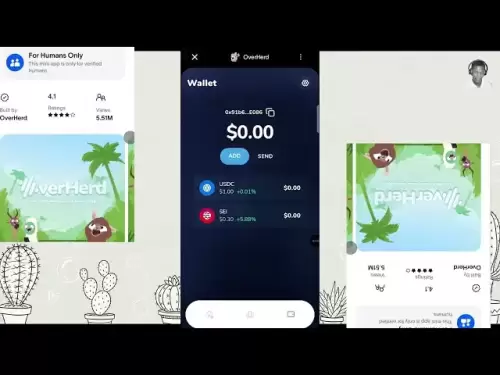-
 Bitcoin
Bitcoin $114200
0.00% -
 Ethereum
Ethereum $3637
0.56% -
 XRP
XRP $2.950
-2.01% -
 Tether USDt
Tether USDt $0.9999
0.02% -
 BNB
BNB $761.0
0.55% -
 Solana
Solana $164.1
-1.38% -
 USDC
USDC $0.9999
0.02% -
 TRON
TRON $0.3332
0.36% -
 Dogecoin
Dogecoin $0.2012
-0.52% -
 Cardano
Cardano $0.7261
-1.41% -
 Hyperliquid
Hyperliquid $37.62
-2.13% -
 Stellar
Stellar $0.3930
-2.65% -
 Sui
Sui $3.441
-0.16% -
 Bitcoin Cash
Bitcoin Cash $563.8
0.70% -
 Chainlink
Chainlink $16.50
0.09% -
 Hedera
Hedera $0.2424
-0.14% -
 Ethena USDe
Ethena USDe $1.001
0.01% -
 Avalanche
Avalanche $22.20
0.00% -
 Litecoin
Litecoin $118.0
-2.48% -
 UNUS SED LEO
UNUS SED LEO $8.991
0.12% -
 Toncoin
Toncoin $3.195
-3.87% -
 Shiba Inu
Shiba Inu $0.00001217
0.12% -
 Uniswap
Uniswap $9.674
-0.21% -
 Polkadot
Polkadot $3.633
1.00% -
 Monero
Monero $295.3
-0.82% -
 Dai
Dai $0.9999
0.00% -
 Bitget Token
Bitget Token $4.321
-0.41% -
 Cronos
Cronos $0.1392
0.73% -
 Pepe
Pepe $0.00001027
-0.89% -
 Aave
Aave $258.5
0.32%
How to trade OKX contract
Understanding contracts, opening an account on OKX, funding it with cryptocurrency, and selecting a contract are essential steps before trading contracts on this leading cryptocurrency exchange.
Nov 10, 2024 at 10:24 pm

A Comprehensive Guide to Trading Contracts on OKX
OKX is a leading cryptocurrency exchange that offers a wide range of trading products, including spot trading, futures trading, and options trading. In this guide, we will focus on how to trade contracts on OKX.
1. Understanding Contracts
Contracts are derivative instruments that allow traders to speculate on the future price of an underlying asset, such as a cryptocurrency or commodity. When you trade a contract, you are essentially entering into an agreement to buy or sell the underlying asset at a predetermined price at a future date.
There are two main types of contracts: futures contracts and perpetual contracts. Futures contracts have a fixed expiry date, while perpetual contracts do not. This means that perpetual contracts can be held indefinitely.
2. Opening an Account on OKX
The first step to trading contracts on OKX is to open an account. You can do this by visiting the OKX website and clicking on the "Sign Up" button. Once you have created an account, you will need to verify your identity by providing a government-issued ID and proof of address.
3. Funding Your Account
Once your account is verified, you will need to fund it with cryptocurrency. You can do this by depositing cryptocurrency from another wallet or by purchasing cryptocurrency directly from OKX.
4. Selecting a Contract
The next step is to select the contract that you want to trade. OKX offers a wide range of contracts, including contracts on Bitcoin, Ethereum, Litecoin, and other cryptocurrencies.
5. Placing an Order
Once you have selected a contract, you can place an order. You can choose to buy (long) or sell (short) the contract. You will also need to specify the order type and the quantity of contracts that you want to trade.
6. Monitoring Your Trades
Once you have placed an order, you can monitor its status by clicking on the "Orders" tab in the OKX interface. You can also view the live market data for the contract that you are trading by clicking on the "Markets" tab.
7. Closing Your Trades
When you are finished trading, you can close your trades by clicking on the "Close" button in the OKX interface. You can choose to close all of your trades at once or just a portion of them.
8. Withdrawing Your Profits
Once you have closed your trades, you can withdraw your profits by clicking on the "Withdraw" button in the OKX interface. You can withdraw your profits to another wallet or to your bank account.
Trading Fees
OKX charges a trading fee for each contract that is traded. The trading fee varies depending on the contract that you are trading and the order type that you use. You can view the trading fees for each contract by clicking on the "Fees" tab in the OKX interface.
Risks of Trading Contracts
Trading contracts can be risky. The price of the underlying asset can fluctuate significantly, and you could lose money on your trades. It is important to understand the risks involved in trading contracts before you get started.
Disclaimer:info@kdj.com
The information provided is not trading advice. kdj.com does not assume any responsibility for any investments made based on the information provided in this article. Cryptocurrencies are highly volatile and it is highly recommended that you invest with caution after thorough research!
If you believe that the content used on this website infringes your copyright, please contact us immediately (info@kdj.com) and we will delete it promptly.
- Binance, CZ, and the FTX Fallout: The $1.8 Billion Question
- 2025-08-06 18:30:12
- Brendan Rodgers, Celtic, and the Greg Taylor Role: A Tactical Conundrum
- 2025-08-06 18:50:12
- Coinbase Stock, Investment, and Earnings: Navigating Crypto's Tides
- 2025-08-06 18:55:54
- DALPY Coin: Investor Buzz Swirls Around Upcoming 'Game-Changing' Features
- 2025-08-06 18:30:12
- Fast-Moving Cryptos: Could Pudgy Penguins Deliver High Gains by 2025?
- 2025-08-06 16:30:11
- Crypto Gaming Tokens: August 2025 Investment Opportunities
- 2025-08-06 16:50:12
Related knowledge

Why is my Bitstamp futures position being liquidated?
Jul 23,2025 at 11:08am
Understanding Futures Liquidation on BitstampFutures trading on Bitstamp involves borrowing funds to open leveraged positions, which amplifies both po...

How to report Bitstamp futures for taxes?
Jul 30,2025 at 08:35am
Understanding Bitstamp Futures and Taxable EventsWhen trading Bitstamp futures, it’s essential to recognize that these financial instruments are treat...

Does Bitstamp offer inverse contracts?
Jul 23,2025 at 01:28pm
Understanding Inverse Contracts in Cryptocurrency TradingIn the realm of cryptocurrency derivatives, inverse contracts are a specific type of futures ...

What is the difference between futures and perpetuals on Bitstamp?
Jul 27,2025 at 05:08am
Understanding Futures Contracts on BitstampFutures contracts on Bitstamp are financial derivatives that allow traders to speculate on the future price...

How to find your Bitstamp futures trade history?
Jul 23,2025 at 08:07am
Understanding Bitstamp and Futures Trading AvailabilityAs of the current state of Bitstamp’s service offerings, it is critical to clarify that Bitstam...

Can I use a trailing stop on Bitstamp futures?
Jul 23,2025 at 01:42pm
Understanding Trailing Stops in Cryptocurrency TradingA trailing stop is a dynamic type of stop-loss order that adjusts automatically as the price of ...

Why is my Bitstamp futures position being liquidated?
Jul 23,2025 at 11:08am
Understanding Futures Liquidation on BitstampFutures trading on Bitstamp involves borrowing funds to open leveraged positions, which amplifies both po...

How to report Bitstamp futures for taxes?
Jul 30,2025 at 08:35am
Understanding Bitstamp Futures and Taxable EventsWhen trading Bitstamp futures, it’s essential to recognize that these financial instruments are treat...

Does Bitstamp offer inverse contracts?
Jul 23,2025 at 01:28pm
Understanding Inverse Contracts in Cryptocurrency TradingIn the realm of cryptocurrency derivatives, inverse contracts are a specific type of futures ...

What is the difference between futures and perpetuals on Bitstamp?
Jul 27,2025 at 05:08am
Understanding Futures Contracts on BitstampFutures contracts on Bitstamp are financial derivatives that allow traders to speculate on the future price...

How to find your Bitstamp futures trade history?
Jul 23,2025 at 08:07am
Understanding Bitstamp and Futures Trading AvailabilityAs of the current state of Bitstamp’s service offerings, it is critical to clarify that Bitstam...

Can I use a trailing stop on Bitstamp futures?
Jul 23,2025 at 01:42pm
Understanding Trailing Stops in Cryptocurrency TradingA trailing stop is a dynamic type of stop-loss order that adjusts automatically as the price of ...
See all articles

























































































